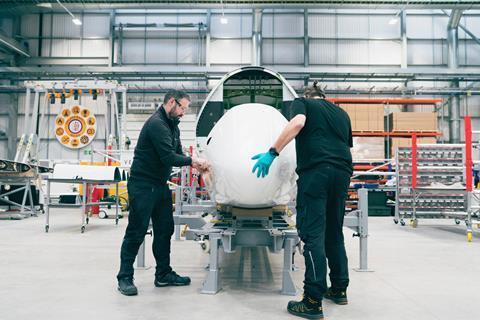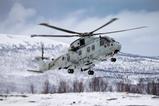Vertical Aerospace expects to complete its second VX4 prototype “in the coming weeks”, leading to the restart of its flight-test programme in the second quarter.
UK-based start-up Vertical has already flown a full-scale prototype of its electric vertical take-off and landing (eVTOL) aircraft, although this was written off following a crash during uncrewed testing last August.

With the loss of its only flight-test asset, the timely arrival of the second “more advanced” prototype is vital to Vertical’s ambition of achieving service entry by the end of 2026.
Detailing the progress with the next prototype in a letter to shareholders issued on 14 March, Vertical says the aircraft is in the final stages of assembly at partner GKN Aerospace’s Global Technology Centre near Bristol.
“In the coming weeks, we expect to complete final assembly of our second, more advanced full-scale VX4 prototype,” it says.
Crucially, it will include second-generation propellers – a blade failure was responsible for the August accident – and its in-house-developed battery pack. In all, around 70% of the prototype’s components are new.
“This aircraft will be significantly more sophisticated, faster and quieter than our first prototype, and from a technology standpoint will be similar to the aircraft we intend to take to certification,” says chief executive Stephen Fitzpatrick. “Our first prototype outperformed, so I have huge expectations for this one.”
An “identical twin” of that aircraft is scheduled to roll-out in the second half, allowing the company“to accelerate our flight-test programme”.
Questions still remain over the propulsion system supplier, however. Rolls-Royce Electrical was selected in 2021 to provide the electric motors and distribution system, but these will not be ready for the second prototype. In addition, the UK engine specialist last November announced that its electrical business was up for sale.
In its annual filing to the US Securities and Exchange Commission, Vertical points to “a binding contract with Rolls-Royce” for the development work and notes: “Rolls-Royce has no right to exit its obligations under it… without our consent”.
“We have been in, and continue to progress, discussions with Rolls-Royce regarding their stated intention to exit [the electical business], whilst exploring potential alternative suppliers in accordance with good supply chain practice,” it adds.
“While these discussions take place, Rolls-Royce continues to perform its contract with us.”
Vertical anticipates the start of crewed flight testing, initially with the aircraft tethered, in the second quarter, although that hinges on obtaining a permit to fly from the UK Civil Aviation Authority (CAA).
“We have already developed our flight clearance strategy for this prototype, which we are explaining in the required comprehensive submission to the CAA for review of our flight-test programme.
“Seventy percent of these documents have already been produced and shared with the CAA in order to permit first flights with this new aircraft,” it says.
Piloted tests will continue through the spring and summer and will include hover and thrust-borne flight phases.
Wing-borne flight tests – using a conventional take-off and landing profile – will follow, “before engaging in piloted transition flights in the summer”, Vertical adds.
Public flight demonstrations of the VX4 are still targeted this year, including at July’s Farnborough air show and at Heathrow airport – part of a wider eVTOL feasibility study – and vertiport operator Skyports’ newly announced testbed in Bicester, around 50 miles (85km) to the northwest of London.
Funded by the UK government-backed Future Flight Challenge, the Bicester site is expected to open by the end of 2024.
Vertical forecasts it will spend around £70 million ($90 million) this year, “which will be used primarily to fund the creation and testing of the prototype aircraft, and to support the certification process,” it says. That figure is roughly in line with the near £75 million it spent in 2023.
In January, Fitzpatrick agreed to inject up to $50 million of his own money into Vertical, “extending [the] cash runway” into the second quarter of 2025.
An initial $25 million tranche was received from Fitzpatrick on 13 March, the company says. The remainder – which could be less than $25 million if outside investors also contribute – is due on 31 July.
“We have been deepening our engagement with outside investors and look forward to launching further fundraising activity over the course of this year,” says Vertical.
As of 14 March, the company held approximately £52 million of cash and cash equivalents.
In its SEC filing, Vertical says it ”will require additional financing to be in a position to continue to carry out our business plans prior to the commercialisation of our aircraft.”































